SRT Marine Systems plc 403-0002 Class B AIS Transceiver User Manual Neon Manual Book v1 5
Software Radio Technology plc Class B AIS Transceiver Neon Manual Book v1 5
Contents
- 1. user manual
- 2. User manual
user manual

Class B AIS transceiver
instruction manual
Neon manual v1.4
Thank you for buying this AIS Class B transceiver.
This product has been engineered to offer you the highest level of
performance and durability and we hope that it will provide many years of
reliable service. We constantly strive to achieve the highest possible
quality standards, should you encounter any problems with this product,
please contact your dealer who will be pleased to offer whatever
assistance you require.

1 Notices ..................................................................................................1
1.1 Safety warnings......................................................................................1
1.2 General notices ......................................................................................1
2 About your AIS class B transceiver ...................................................3
2.1 About AIS ...............................................................................................3
2.2 Static and dynamic vessel data..............................................................3
2.3 Important information for US customers.................................................4
2.4 What's in the box? ..................................................................................5
3 Installation ............................................................................................7
3.1 Preparing for Installation ........................................................................7
3.2 Installation procedures ...........................................................................9
4 Configuring your AIS transceiver .....................................................15
4.1 Switching on your AIS transceiver for the first time..............................15
4.2 Introduction to the proAIS software ......................................................16
4.3 Installing the proAIS software...............................................................16
4.4 Configuration using proAIS ..................................................................17
5 Operation ............................................................................................19
5.1 Using the AIS transceiver.....................................................................19
5.2 Switch functions ...................................................................................19
5.3 Using proAIS with your AIS transceiver ...............................................20
5.4 Indicator functions ................................................................................23
6 Troubleshooting .................................................................................24
7 Specifications .....................................................................................25
8 Warranty..............................................................................................26
Figure 1 Items included in the product..................................................... 5
Figure 2 AIS transceiver overview ........................................................... 6
Figure 3 Electrical connections to the AIS transceiver ............................ 6
Figure 4 Typical installation configuration................................................ 7
Figure 5 AIS transceiver dimensions ..................................................... 10
Figure 6 AIS transceiver mounting ........................................................ 10
Figure 7 GPS antenna mounting ........................................................... 11
Figure 8 Position of the GPS antenna connector .................................. 11
Figure 9 Position of the VHF antenna connector................................... 12
Figure 10 Connecting an external switch................................................. 12
Figure 11 Connecting to the NMEA0183 data port.................................. 13
Figure 12 Connecting the power supply .................................................. 14
Figure 13 Indicator start up sequence ..................................................... 15
Figure 14 Entering static data into proAIS ............................................... 16
Figure 15 proAIS GPS status page ......................................................... 20
Figure 16 proAIS Diagnostics page ......................................................... 21
Figure 17 proAIS Other vessels page...................................................... 21
Figure 18 proAIS Messages page ........................................................... 22
Figure 19 proAIS Serial data page .......................................................... 22
Figure 20 Indicator location on the AIS transceiver unit .......................... 23
Table of contents Table of figures

Notices
Page 1
1 Notices
1.1 Safety warnings
1.2 General notices
Position source
All marine Automatic Identification System (AIS) transceivers utilise
a satellite based location system such as the Global Positioning
Satellite (GPS) network.
The accuracy of a GPS position fix is variable and is affected by
factors such as the antenna positioning, how many satellites are
used to determine a position and how long satellite information has
been received for.
Compass safe distance
The compass safe distance of this unit is 0.5m or greater for 0.3°
deviation.
RF emissions notice
Caution: The AIS transceiver generates and radiates radio
frequency electromagnetic energy. This equipment must be
installed and operated according to the instructions contained in this
manual. Failure to do so can result in personal injury and / or AIS
transceiver malfunction.
Caution: Never operate the AIS transceiver unless it is connected to
a VHF antenna.
To maximise performance and minimise human exposure to radio
frequency electromagnetic energy you must make sure that the
antenna is mounted at least 1.5 meters away from the AIS
transceiver and is connected to the AIS transceiver before power is
applied.
The system has a Maximum Permissible Exposure (MPE) radius of
1.5m. This has been determined assuming the maximum power of
the AIS transceiver and using antennas with a maximum gain of
3dBi.
The antenna should be mounted 3.5m above the deck in order to
meet RF exposure requirements. Higher gain antennas will require
a greater MPE radius.
Do not operate the unit when anyone is within the MPE radius of the
antenna (unless they are shielded from the antenna field by a
grounded metallic barrier).
!
When reading this manual please pay attention to
warnings marked with the warning triangle shown on
the left. These are important messages for safety,
installation and usage of the product.
!
This equipment must be installed in accordance with
the instructions provided in this manual.
!
This equipment is intended as an aid to navigation and
is not a replacement for proper navigational judgement.
!
Do not install this equipment in a flammable
atmosphere such as in an engine room or near to fuel
tanks.

Notices
Page 2
The antenna should not be co-located or operated in conjunction
with any other transmitting antenna.
The required antenna impedance is 50 ohms.
Warranty
This product is supplied with standard warranty as defined in
section 8.
Disposal of this product and packaging
Please dispose of the AIS transceiver in accordance with the
European WEEE Directive or with the applicable local regulations
for disposal of electrical equipment.
Every effort has been made to ensure the packaging for this product
is recyclable. Please dispose of the packaging in an
environmentally friendly manner.
Accuracy of this manual
The AIS transceiver may be upgraded from time to time and future
versions of the AIS transceiver may therefore not correspond
exactly with this manual. Information contained in this manual is
liable to change without notice. The manufacturer of this product
disclaims any liability for consequences arising from omissions or
inaccuracies in this manual and any other documentation provided
with this product.
Declaration of conformity
The manufacturer of this product declares that this product is in
compliance with the essential requirements and other provisions of
the R&TTE directive 1995/5/EC.
The product carries the CE mark, notified body number and alert
symbol as required by the R&TTE directive.
The product is intended for sale in the following member states:
Great Britain, France, Spain, Sweden, Austria, Netherlands,
Portugal, Denmark, Norway, Belguium, Italy, Finland, Ireland,
Luxembourg, Germany, Czech Republic.
FCC notice
This equipment has been tested and found to comply with the limits
for a Class B digital device, pursuant to part 15 of the FCC Rules.
These limits are designed to provide reasonable protection against
harmful interference in a residential installation.
This equipment generates, uses and can radiate radio frequency
energy and, if not installed and used in accordance with the
instructions, may cause harmful interference to radio
communications.
!
Any attempt to tamper with or damage this product will
invalidate the warranty.
!
WARNING: It is a violation of the rules of the Federal
Communications Commission to input an MMSI that
has not been properly assigned to the end user, or to
otherwise input any inaccurate data in this device.

About your AIS class B transceiver
Page 3
2 About your AIS class B
transceiver
2.1 About AIS
The marine Automatic Identification System (AIS) is a location and
vessel information reporting system. It allows vessels equipped with
AIS to automatically and dynamically share and regularly update
their position, speed, course and other information such as vessel
identity with similarly equipped vessels. Position is derived from the
Global Positioning System (GPS) and communication between
vessels is by Very High Frequency (VHF) digital transmissions.
There are a number of types of AIS device as follows:
•Class A transceivers. These are similar to Class B transceiver,
but are designed to be fitted to large vessels such as cargo ships
and large passenger vessels. Class A transceivers transmit at a
higher VHF signal power than class B transceivers and therefore
can be received by more distant vessels, and also transmits
more frequently. Class A transceivers are mandatory on all
vessels over 300 gross tonnes on international voyages and
certain types of passenger vessels under the SOLAS mandate.
•Class B transceivers. Similar to Class A transceivers in many
ways, but are normally lower cost due to the less stringent
performance requirements. Class B transceivers transmit at a
lower power and at a lower reporting rate than Class A
transceivers.
•AIS basestations. AIS basestations are used by Vessel Traffic
Systems to monitor and control the transmissions of AIS
transceivers.
•Aids to Navigation (AtoN) transceivers. AtoNs are
transceivers mounted on buoys or other hazards to shipping
which transmit details of their location to the surrounding vessels.
•AIS receivers. AIS receivers will generally receive
transmissions from Class A transceivers, Class B transceivers,
AtoNs and AIS basestations but do not transmit any information
about the vessel on which they are installed.
2.2 Static and dynamic vessel data
There are two categories of information transmitted by an
AIS transceiver: static and dynamic data.
The vessel's dynamic data, which includes location, speed over
ground (SOG) and course over ground (COG), is calculated
automatically using the internal GPS receiver.
Static data is information about the vessel which must be
programmed into the AIS transceiver. This includes:
• Maritime Mobile Service Identity (MMSI)
• Vessel name
• Vessel call sign (if available)
• Vessel type
• Vessel dimensions
In most countries the operation of an AIS transceiver is included
under the vessel's marine VHF licence provisions. The vessel on to

About your AIS class B transceiver
Page 4
which the AIS unit is to be installed must therefore possess a
current VHF radiotelephone licence which lists the AIS system,
vessel Call Sign and MMSI number.
2.3 Important information for US
customers
There are specific laws in the USA regarding the configuration of
AIS class B transceivers.
If you are a US resident and intend to use your AIS class B
transceiver in US waters, you should make sure that your retailer
has configured your product prior to supplying it to you. If your AIS
transceiver has not been pre-configured please contact your dealer
for details of how to have it configured.
!
An MMSI number is required in order for the AIS
transceiver to operate. Please contact the relevant
authority in your country for more information.
!
In the United States of America, the MMSI and static
data must only be entered by a competent installer.
The end user of the equipment is not authorised to
enter their own static data.

About your AIS class B transceiver
Page 5
2.4 What's in the box?
Figure 1 shows the items included with your AIS transceiver
purchase. The following sections give a brief overview of each item.
Please ensure all items are present and if any of the items are not
present contact your dealer.
Figure 1 Items included in the product
• Support tools CD
The CD supplied with the package contains the proAIS software tool
necessary to configure the AIS transceiver. Please refer to section
4 for details of the configuration process and how to use the proAIS
tool.
• Quick start guide
The quick start guide gives a handy one page reference for the
installation process.
• Product manual
This document is the product manual and should be read thoroughly
prior to any attempt to install or use the AIS transceiver.
• GPS antenna
The GPS antenna forms an integral part of the product's internal
positioning system based on GPS. Please refer to section 3.2 for
details of how to install the GPS antenna.
• Fixing screws
Four fixing screws are provided with the product for mounting of the
AIS transceiver. Please refer to section 3.2 for details of how to
mount the AIS transceiver.
• AIS transceiver unit
Figure 2 shows an overview of the AIS transceiver unit.
The AIS transceiver has a number of indicators which provide
information to the user about the status of the AIS transceiver.
Please refer to section 5.4 for more details of indicator functions.
The AIS transceiver has a single switch which can be configured to
provide certain functions as defined in section 5.2.
Screws
(packet of 4)
Product CD
Quick
start guide
Product manual
GPS Antenna
Class B AIS transceiver
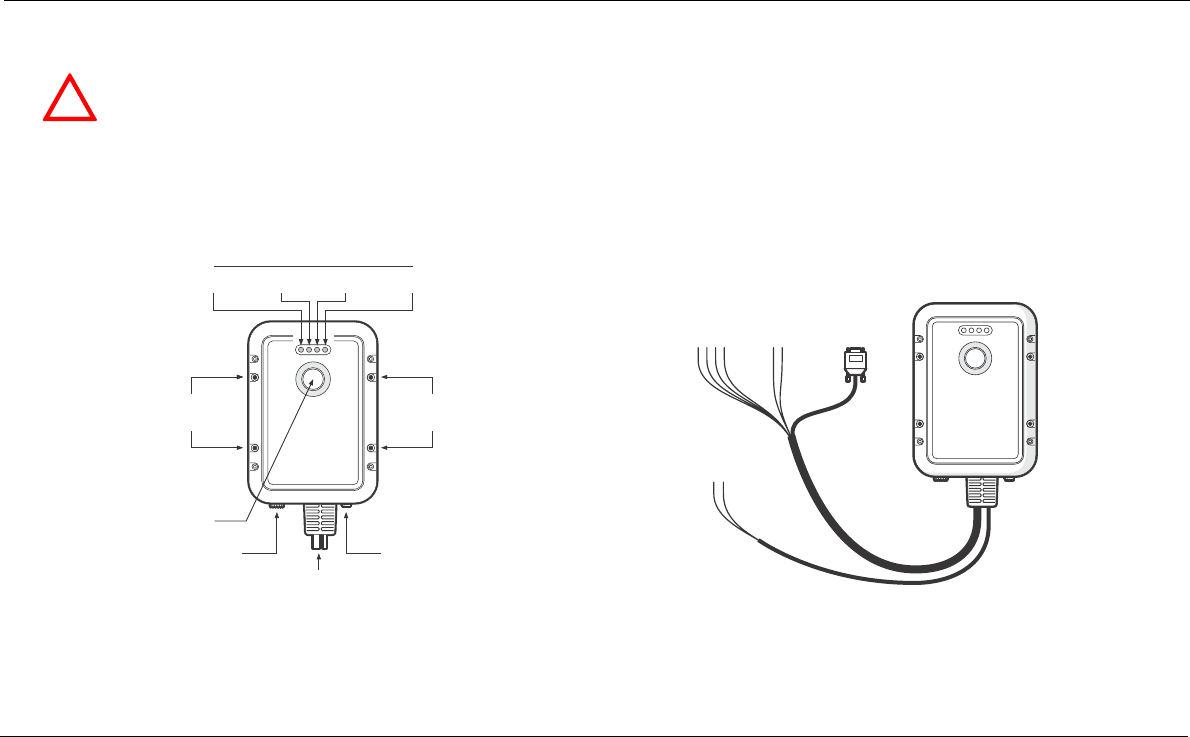
About your AIS class B transceiver
Page 6
Figure 2 shows the AIS transceiver mounting holes. Please refer to
section 3.2 for details of how to mount the AIS transceiver.
Figure 2 AIS transceiver overview
Electrical connections
The AIS transceiver has the following connections provided by the
attached cables:
• Power supply
• NMEA0183 data port for connection to chart plotters
• RS232 for connection to a PC
• External switch input
In addition there are two other connections for the GPS antenna
and the VHF antenna.
Figure 3 Electrical connections to the AIS transceiver
!
Do not attempt to adjust or remove the fixings next to
each of the four mounting holes. These fixings form
part of the sealing of the AIS transceiver and any
modification could affect the product's performance
and will invalidate the product's warranty.
Indicator lights
Switch
Mounting
holes
Mounting
holes
Blue Red Amber Green
Power and data cables
VHF antenna connector GPS antenna connector
Plotter
Power in
Switch RS232
Class B AIS transceiver
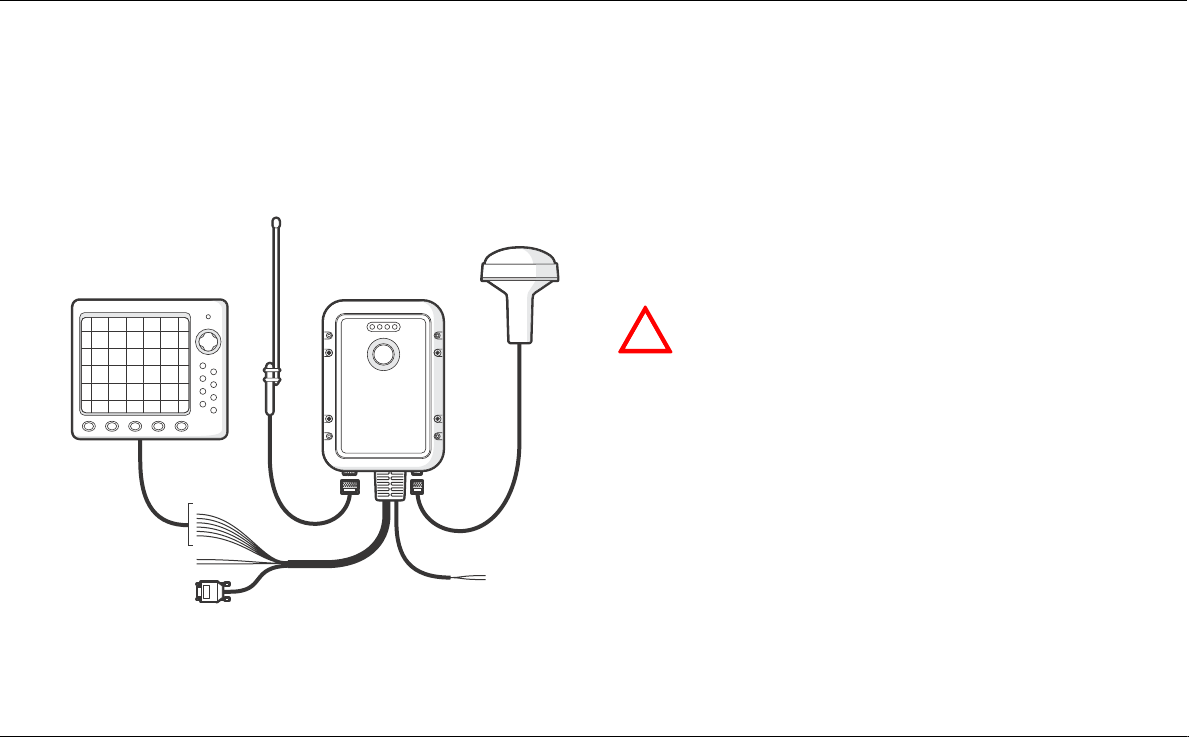
Installation
Page 7
3 Installation
3.1 Preparing for Installation
Figure 4 shows a typical installation configuration for the AIS
transceiver. Please take the time to familiarise yourself with the
system elements and their connections prior to attempting
installation.
Figure 4 Typical installation configuration
In addition to the items provided with your AIS transceiver the
following items will be required for installation:
VHF antenna
Connection to a suitable VHF antenna will be required for the AIS
transceiver to operate. A standard marine band VHF antenna such
as that used with VHF voice radios will be sufficient. Please take
note of the warnings in section 1 regarding the use of antennas.
Alternatively, if you wish to use an existing VHF antenna, antenna
splitter products are available which allow the existing antenna to be
used with two radio devices, such as a VHF voice radio and the AIS
transceiver.
Antenna cables
The GPS antenna is provided with 10 metres of cable. If this is not
sufficient to reach between the desired GPS antenna location and
the AIS transceiver unit you will need an extension cable. Please
contact your dealer for details. For reference the GPS antenna
connector type on the AIS transceiver unit is TNC receptacle, and is
intended to mate with a TNC jack connector.
Switch
Power in
RS232
GPS Antenna
Class B AIS transceiverChartplotter
VHF Antenna
!
When selecting an AIS antenna splitter make sure it is
capable of operation with an AIS transceiver. Some AIS
antenna splitters are designed to work only with AIS
receivers. Please check with your dealer to ensure you
purchase the correct type of antenna splitter.

Installation
Page 8
Please check that the VHF antenna you intend to use has sufficient
cable to reach between the VHF antenna and the AIS transceiver
unit. If it is not sufficient you will need an extension cable. Please
contact your dealer for details of suitable products. For reference
the VHF antenna connector type on the AIS transceiver unit is SO
239, and is intended to mate with a PL 259 connector.
Power and data cables
The AIS transceiver unit is supplied with a one metre long power
and data cable as an integral part of the AIS transceiver unit. If you
require longer cables to reach your power supply, please ensure the
cables are capable of carrying currents of up to 2A peak and 500mA
on average. Means of connecting the cables together will also be
required. The use of ScotchlokTM connectors is recommended for
this purpose.
Chart plotter
To display received AIS messages as other vessels on your chart
plotter, you will need to connect your AIS transceiver to your chart
plotter. Please refer to the user manual supplied with your chat
plotter for details of how to connect and configure your chart plotter
for use with AIS devices. For general guidance your chart plotter
should be configured to accept NMEA data at 38400 baud
(sometimes referred to as 'NMEA HS' in the plotter configuration
menu). You may also need to enable the display of AIS targets in
the chart options.
Connection to a PC
If you choose to use a PC with suitable charting software to display
received AIS messages as other vessels, this can be accomplished
by connecting the RS232 directly to the PC, or via a suitable RS232
to USB converter if your PC does not have a RS232 port.
GPS antenna mount
A one inch 14 TPI pole mount is required to mount the supplied
GPS antenna. Please contact your dealer for details of suitable
products.

Installation
Page 9
3.2 Installation procedures
Before beginning installation of your AIS transceiver, please ensure
you have the necessary additional items as detailed in section 3.1.
It is strongly recommended that you read all of the instructions in
this manual prior to installation.
If after reading this manual you are unsure about any element of the
installation process please contact your dealer for advice.
The following sections explain the installation process step by step
for each of the main elements of the system.
Step 1 - Installing the AIS transceiver
Please note the following guidelines when selecting a location for
your AIS transceiver:
• The AIS transceiver must be fitted in a location where it is at least
0.5m from a compass or any magnetic device.
• There should be adequate space around the AIS transceiver for
routing of cables. See Figure 5 for details of the AIS transceiver
dimensions.
• The ambient temperature around the AIS transceiver should be
maintained between -10°C and +55°C.
• The AIS transceiver should not be located in a flammable or
hazardous atmosphere such as in an engine room or near to fuel
tanks.
• The AIS transceiver is fully waterproof to ingress protection
rating IPx7, however it is recommended that the AIS transceiver
is not subjected to extended periods of exposure to spray or
submersion.
• It is recommended that the AIS transceiver is installed in a 'below
decks' environment.
• It is acceptable to mount the AIS transceiver either vertically or
horizontally.
• The product is supplied with four self tapping screws for
attachment of the AIS transceiver to a suitable surface. Please
refer to Figure 6 for guidance.
• The AIS transceiver should be mounted in a location where the
indicators are readily visible as these provide important
information on the status of the AIS transceiver.
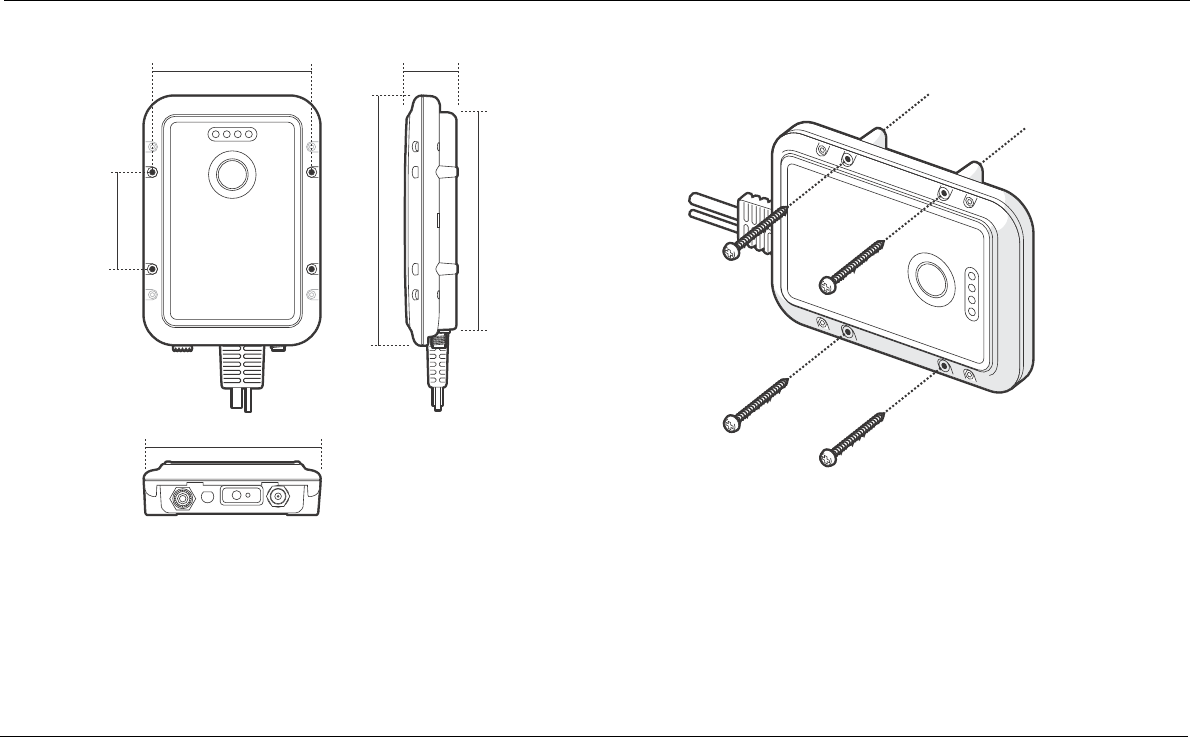
Installation
Page 10
Figure 5 AIS transceiver dimensions
Figure 6 AIS transceiver mounting
215 mm
84 mm
185 mm
150 mm
137 mm 45 mm
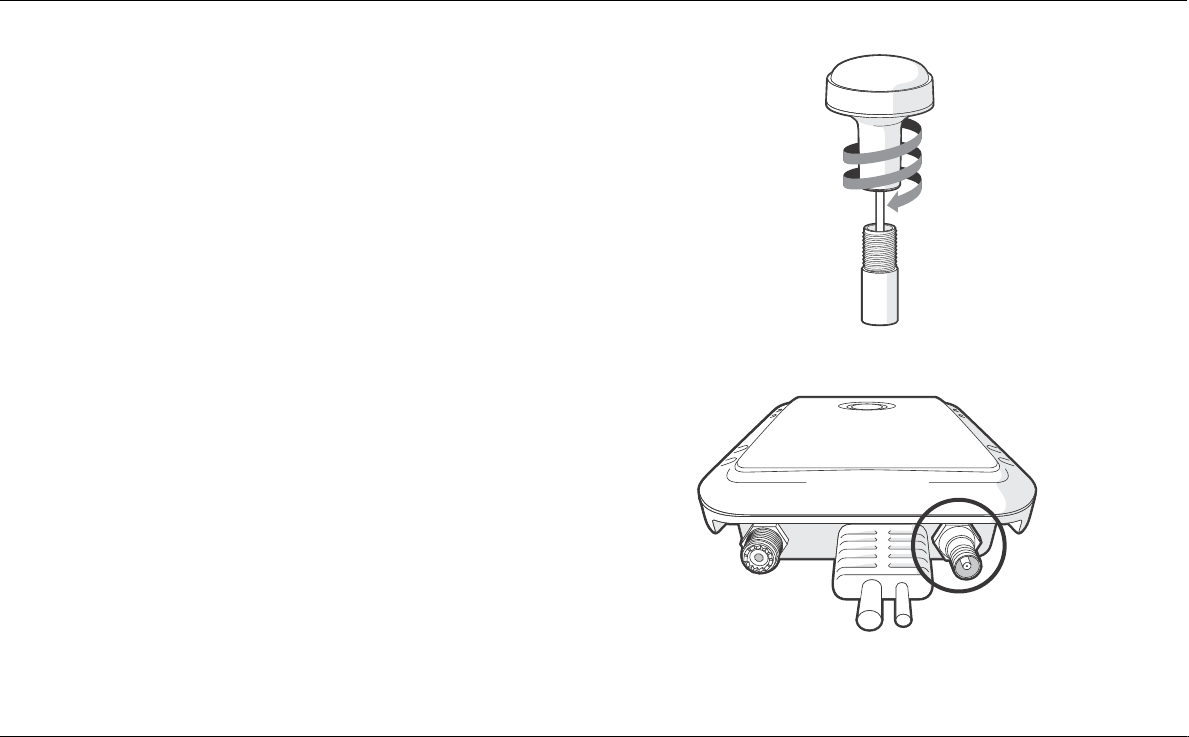
Installation
Page 11
Step 2 - Installing the GPS antenna
For mounting of the GPS antenna provided with your AIS
transceiver you will require a one inch 14 TPI thread pole.
You should ensure the GPS antenna has a good clear view of the
entire sky.
It is not recommended that the GPS antenna is mounted up a mast
where the the motion of the vessel will cause the antenna to swing
and potentially reduce the accuracy of the GPS position.
Do not mount your antenna in the direct path of a radar transmitter.
Feed the ten metre long cable attached to the GPS antenna cable
through the pole and screw the antenna onto the pole mount as
shown in Figure 7.
Route the cable to your AIS transceiver unit, adding any necessary
extension cables.
Connect the cable from the GPS antenna to the GPS connector on
the AIS transceiver as shown in Figure 8.
Figure 7 GPS antenna mounting
Figure 8 Position of the GPS antenna connector
GPS Antenna
VHF Antenna
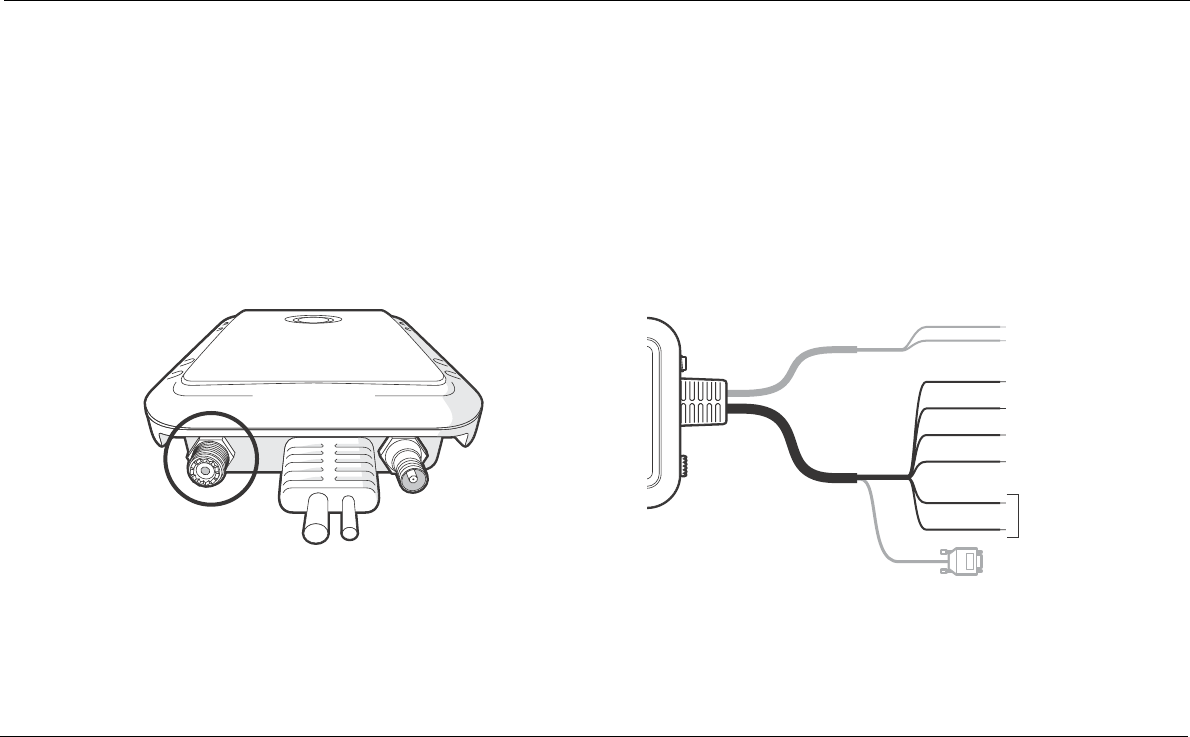
Installation
Page 12
Step 3 - Connecting the VHF antenna
Route the cable from the VHF antenna to the AIS transceiver and
connect to the VHF connector on the AIS transceiver as shown in
Figure 9.
A standard marine band VHF antenna or AIS antenna should be
used with the AIS transceiver. The connector type on the AIS
transceiver is SO239. Your chosen VHF antenna requires a PL259
connector to mate with this. If your VHF antenna does not use this
type of connector please contact your dealer for details of available
adaptors.
Figure 9 Position of the VHF antenna connector
Step 4 - Connecting an external switch
If you require a remote external switch to activate the silent mode
feature, it is possible to connect a toggle switch to the AIS
transceiver and configure the switch function accordingly.
Connect the toggle switch between the orange and blue wires as
shown in Figure 10 and configure the switch function in proAIS to
'Make switch to disable transmitter'. For more details on how to do
this please refer to section 4.4.
Connection of an external switch to toggle silent mode is optional
and not essential for normal operation of the product.
Figure 10 Connecting an external switch
GPS Antenna
VHF Antenna
Yellow
Brown
White
Green
Transmit +
Transmit –
Receive +
Receive –
External switch
connection
Blue
Orange
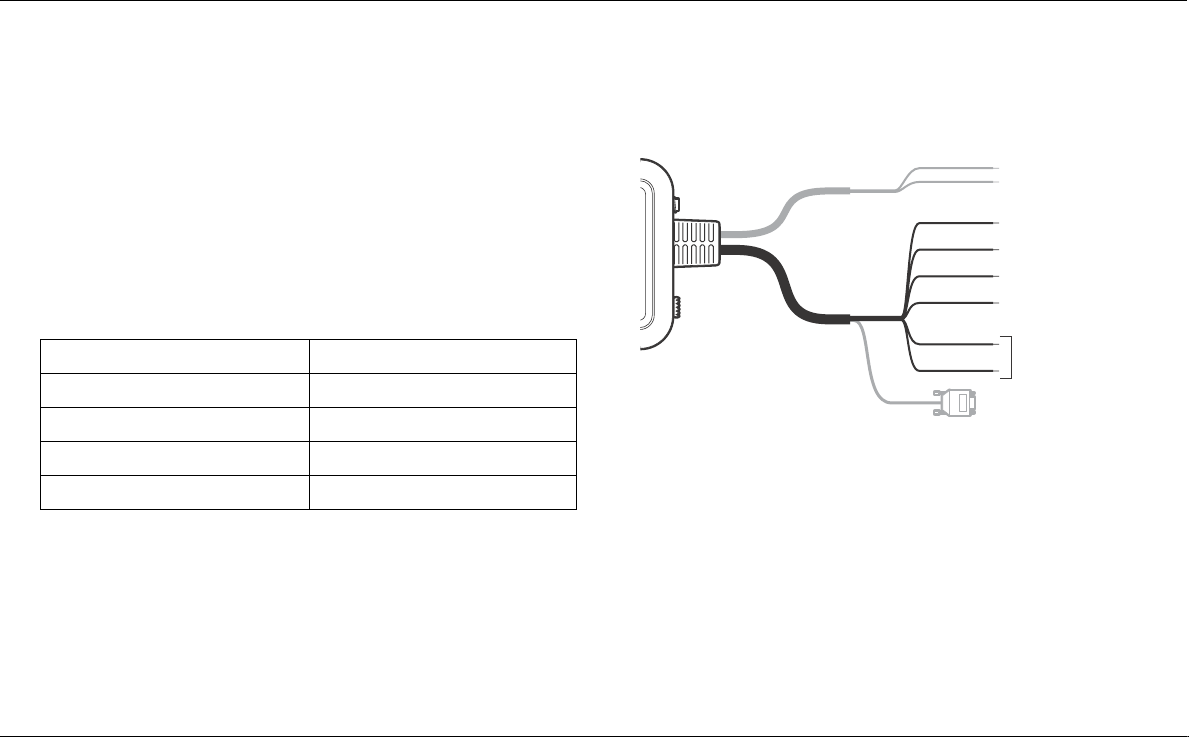
Installation
Page 13
Step 5 - Connecting to a chart plotter
The NMEA0183 data port provides the connection to your chart
plotter and consists of four wires colour coded as shown in the table
below and in Figure 11. Connect the wires to the appropriate
connections on your chart plotter. Please refer to your chart plotter
manual for more information.
N.B. The NMEA0183 data port operates at a baud rate of 38400.
Please ensure your chart plotter is configured to receive data from
the AIS transceiver via its NMEA0183 port at 38400 baud.
Please note that the 'Receive' connections may not be needed
when connecting to your chart plotter as it is not normal for the
transceiver to receive data from the chart plotter.
Connecting an optional NMEA0183 device
If you wish to connect a NMEA0183 device (such as a heading
sensor) to your chart plotter, but your chart plotter only has a single
NMEA0183 input, it is possible to use the AIS transceiver’s
NMEA0183 multplexing feature to connect both devices to the chart
plotter.
To multiplex your NMEA0183 device data via the AIS transceiver
simply connect the device’s NMEA0183 output to the receive+ and
receive- terminals as defined in the table above. Follow the
instructions in section 4.4 to configure the AIS transceiver to
multiplex the devices NMEA0183 data to your chart plotter.
Figure 11 Connecting to the NMEA0183 data port
Connection to a PC
The AIS transceiver is supplied with an RS232 port for connection
to a PC. The RS232 connector can be connected directly to the
RS232 port on the PC or via a serial to USB converter if no RS232
port is available. For configuration of the AIS transceiver it is
necessary to connect to a PC if your AIS transceiver has not been
pre-configured by your dealer. See section 4 for more details of
configuration.
NMEA0183 function Wire colour
Transmit + Yellow
Transmit - Brown
Receive + White
Receive - Green
Yellow
Brown
White
Green
Transmit +
Transmit –
Receive +
Receive –
External switch
connection
Blue
Orange
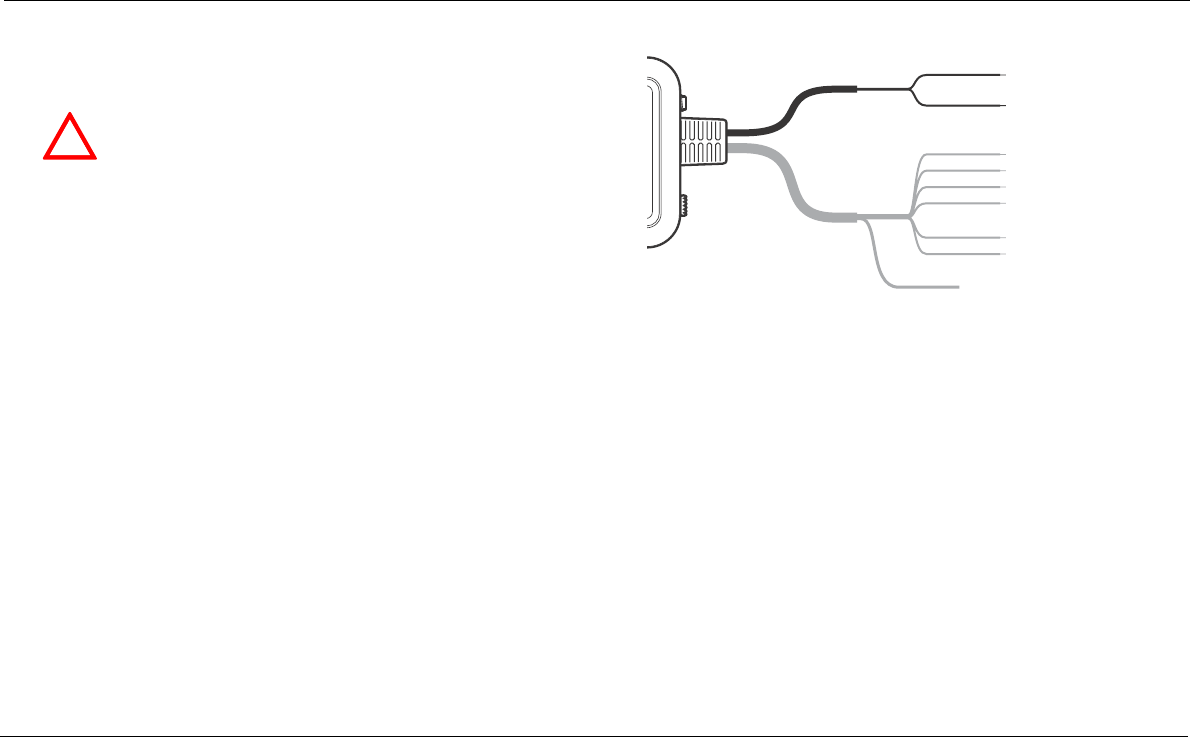
Installation
Page 14
Step 6 - Connecting to a power supply
The AIS transceiver requires a 12V power supply typically provided
by the vessel's battery.
It is recommended that crimped and soldered lugs are used to
connect the AIS transceiver to the power source.
It is recommended that the power supply is connected via a suitable
circuit breaker and/or 3A fuse block.
1. Connect the red wire to a 12V power supply positive terminal.
2. Connect the black wire to the supply negative terminal.
Figure 12 Connecting the power supply
!
Do not use a 24V power supply with the AIS
transceiver. Should a 24V supply be connected to the
AIS transceiver, an internal protection system will be
invoked and the AIS transceiver will not operate as
normal. However, no permanent damage will be
caused to the AIS transceiver. The AIS transceiver will
operate as normal once connected to a 12V power
supply.
Red
Black
Power supply +
Power supply –
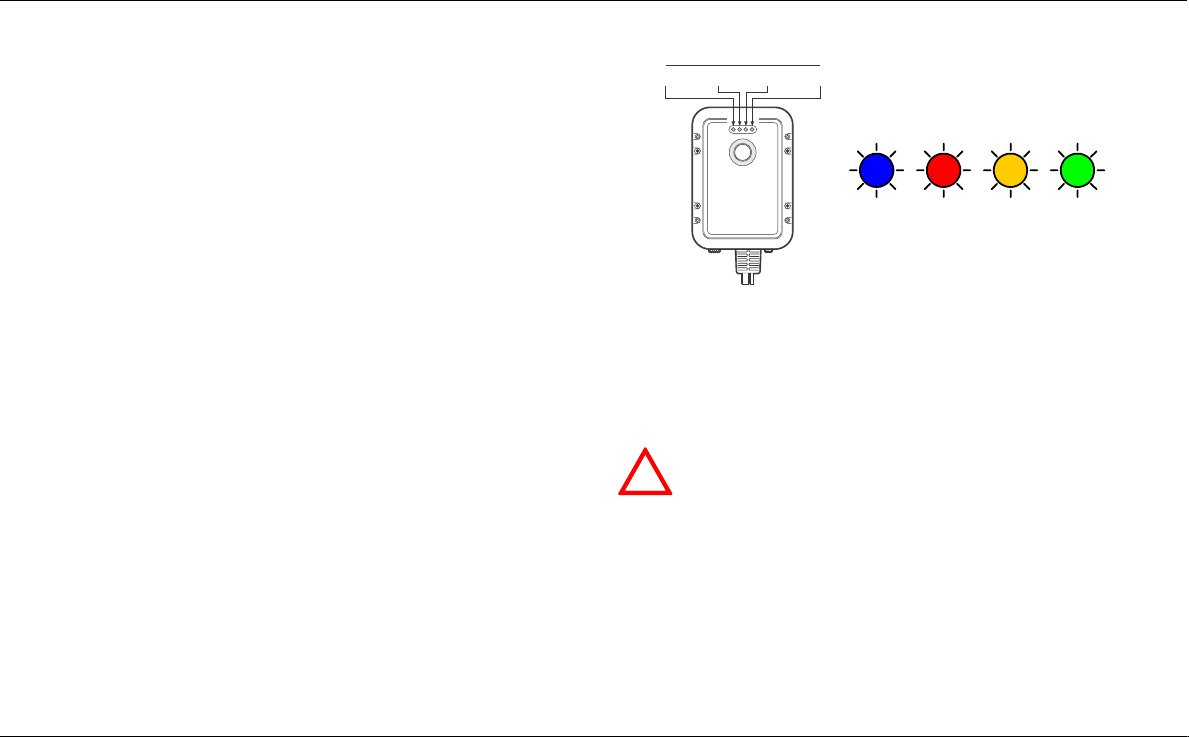
Configuring your AIS transceiver
Page 15
4 Configuring your AIS
transceiver
4.1 Switching on your AIS transceiver
for the first time
A few seconds after applying power to the AIS transceiver for the
first time all four indicators (green, amber, red and blue) will blink
twice. The indicator sequence following this will depend on whether
your transceiver is pre-configured.
Transceiver is pre-configured:
The amber indicator will illuminate until the transceiver has
transmitted an AIS message.
Transceiver is not pre-configured:
The amber and red indicator will illuminate. This indicates the unit
cannot transmit until it is configured with a valid MMSI.
Figure 13 Indicator start up sequence
Prior to use the AIS transceiver requires programming with the
vessel's static data to ensure that the data transmitted by the AIS
transceiver matches that of the host vessel.
Indicator lights
Blue Red Amber Green
!
US Customers only: It is a violation of the rules of the
Federal Communications Commission for the end user
to programme the static data. The static data must only
be programmed by a competent installer. If your AIS
transceiver has not been preconfigured for you please
refer to your dealer for advice on how to have the AIS
transceiver configured by a competent installer.
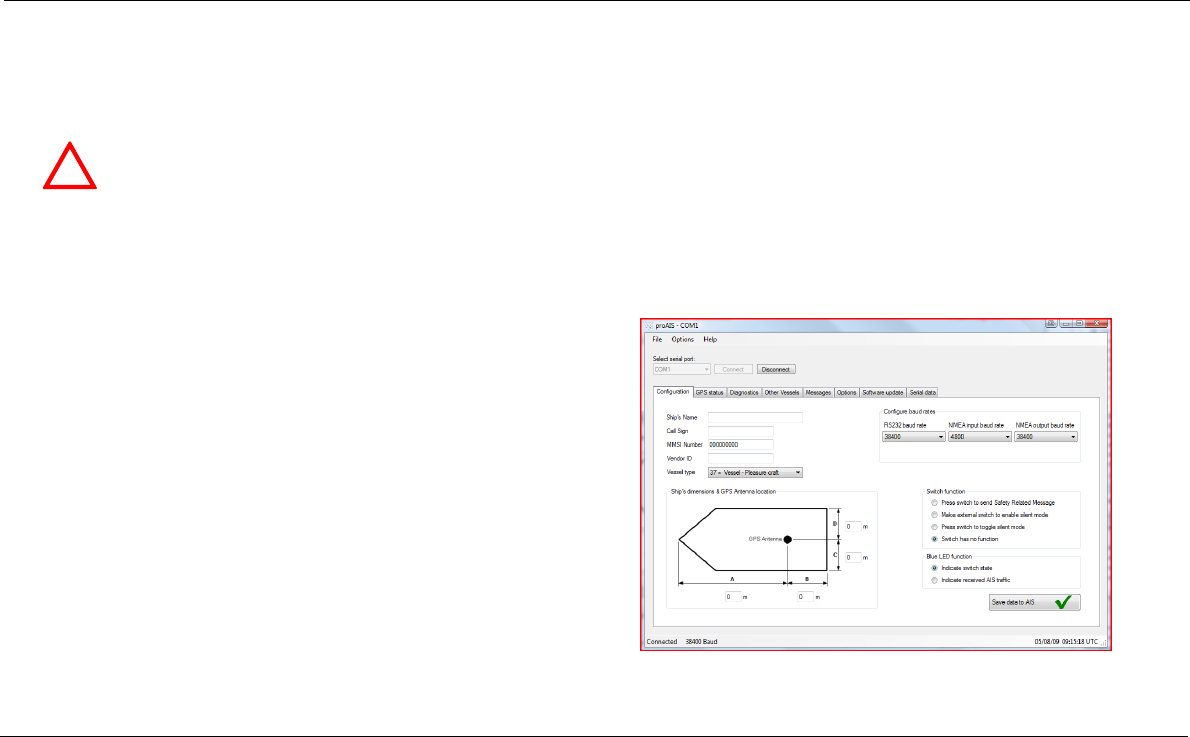
Configuring your AIS transceiver
Page 16
4.2 Introduction to the proAIS software
Included in the CD supplied with your product is a configuration
software tool called 'proAIS'.
proAIS is a software tool which provides the facility to configure,
monitor and diagnose issues with your AIS transceiver.
Section 4.3 provides instructions on how to install the proAIS
software.
Section 4.4 describes how to use proAIS to configure the static data
and other settings for your AIS transceiver.
Section 5.3 describes how to use proAIS to monitor the status of
your AIS transceiver.
4.3 Installing the proAIS software
This software is designed to be installed and used with a PC
connected to the AIS transceiver via the data lead provided as
standard with the AIS transceiver unit. If the PC being used for
programming does not have a 9-pin serial port then a commercially
available USB to serial adaptor may be required. This connects
between the supplied data lead and the PC.
To install proAIS on your PC:
1. Locate and run the setup.exe file on the CD and then follow the
on-screen prompts.
2. If a security warning appears, click 'Install' to continue with the
installation.
3. Once installation is complete, proAIS will launch automatically
and a start menu folder and shortcut will be created for future use.
4. Once proAIS has launched you should see a window as shown
in Figure 14.
5. Please follow the instructions in section 4.4 to configure your
AIS transceiver.
Figure 14 Entering static data into proAIS
!
proAIS is only compatible with Windows based
operating systems and is not compatible with Apple
MAC operating systems.

Configuring your AIS transceiver
Page 17
4.4 Configuration using proAIS
Follow the steps below to configure the AIS transceiver:
1. Connect your AIS transceiver to the PC using the RS232 lead as
described in section 3.2. Apply 12V power to the AIS transceiver as
described in section 3.2.
2. Select the appropriate serial port in proAIS and press 'Connect'.
3. proAIS should launch with the 'static data' page active (see
Figure 14). If this is not the case please select the 'static data' page.
4. Carefully enter the data fields on the screen including:
• MMSI - the vessel's MMSI must be 9 digits in length and should
be the same as that used for any other digital radio equipment
such as a VHF DSC radio.
• Ship's name - the ship's name can be up to 20 characters in
length.
• Call sign - the call sign can be up to seven characters in length.
Not all vessels are issued with a call sign and it is acceptable to
leave this field blank.
• Vessel type - select a vessel type from the drop down list which
most closely matches your vessel.
• GPS antenna location - use the on-screen guide to specify the
distances from your GPS antenna to the edges of the vessel as
shown. The distances are entered in metres.
5. Select the desired switch from the following options:
• Press switch to send safety related message.
• Make switch to disable transmitter (This is required if you intend
to use an external toggle switch to control silent mode).
• Press switch to toggle transmitter on/off (This is required if you
intend to use the integrated switch to toggle silent mode).
• Switch has no function.
Please note: the integrated switch can only provide one of these
functions at any one time. If you wish to change the function of the
switch please return to this configuration process.
6. Set the blue indicator function.
• The blue indicator can be configured to show either the status of
the switch or to show when AIS messages are being received
from other vessels.
• Note that the blue indicator cannot perform both functions
simultaneously.
!
Please ensure that you enter all static data accurately.
Failure to do so could result in other vessels failing to
identify your vessel correctly.
!
The vessel MMSI can only be programmed once using
proAIS, please take care to programme your MMSI
correctly. If you need to change the MMSI for any
reason, please contact your dealer who will arrange to
have the MMSI reset.

Configuring your AIS transceiver
Page 18
7. Set the baud rates to the required level for each of the serial
ports.
• Set the RS232 baud rate to the required level. The default is
38,400. This is the baud rate used when communicating with a
PC via the RS232 connection.
• Set the NMEA output (transmit) baud rate to the required level.
The default is 38,400. This is the baud rate used when
transmitting data to a chart plotter via its NMEA0183 input.
• Set the NMEA input (receive) baud rate to the required level.
The default is 4,800. If you are using an optional NMEA0183
device such as a heading sensor (see section 3.2) please select
the baud rate at which the NMEA0183 device is transmitting
data. If you are not using an optional NMEA0183 device this
baud rate should be set to the same level as the NMEA transmit
baud rate.
7. Once all data has been entered correctly, press 'Save static data
to AIS unit'. This will permanently store the data to the unit.
8. You will see a pop-up window warning you that the MMSI can
only be entered once and should therefore be entered correctly.
Please double check you have entered the correct MMSI.
9. All other static data can be modified by repeating the steps
above.
10. If you need to change the MMSI for any reason please contact
your dealer who will be able to reset the unit.

Operation
Page 19
5 Operation
5.1 Using the AIS transceiver
Once the unit has been configured it is ready for use. Providing
other vessels with AIS transceivers installed are within radio range
of your vessel you should see their details appear on your chart
plotter or PC. These vessels will also be able to see your vessel on
their chart plotter or PC. It may take up to six minutes for your full
vessel details to be visible to others.
Specific details of how to configure your chart plotter to make use of
the AIS transceiver features will be given in your chart plotter
manual. If you are using charting software running on a PC, please
refer to the instructions provided with your chart plotting software for
details of how to configure it to display AIS information.
5.2 Switch functions
The integrated switch on the top of the unit (see Figure 2) can be
configured either to trigger transmission of a "Safety Related
Message" or to place the unit into "Silent mode". This choice is
made during configuration of the unit using the proAIS application;
please refer to 4.4 for further information on the configuration
options.
Safety related message
When configured to transmit a safety related message (SRM) the
switch will initiate broadcast of an AIS message containing the
vessels MMSI along with the text "MAYDAY MAYDAY". The switch
must be pressed for at least two seconds to initiate this transmission
(to avoid accidental activation) and the blue indicator will illuminate
to indicate the message has been sent. Further safety related
messages cannot be sent until the blue indicator has extinguished
which will occur one minute after an SRM has been sent.
Silent mode
When configured to place the unit into "Silent mode", each press of
the switch will toggle the AIS transmitter on or off. The switch must
be depressed for two seconds to activate silent mode to avoid
accidental activation. When the transmitter is off, the amber and
blue indicators will be illuminated and the AIS transceiver's position
will not be broadcast to other vessels. The position of other vessels
will still be received by the unit.
Silent mode can be used if you wish to only receive AIS messages
from other vessels but keep your own details private from other AIS
users.
!
The SRM function is not a primary means of distress
call and cannot be relied upon as a means of distress
call.
!
Your vessel will not be displayed on other users, chart
plotters or PCs while your AIS transceiver is in silent
mode.
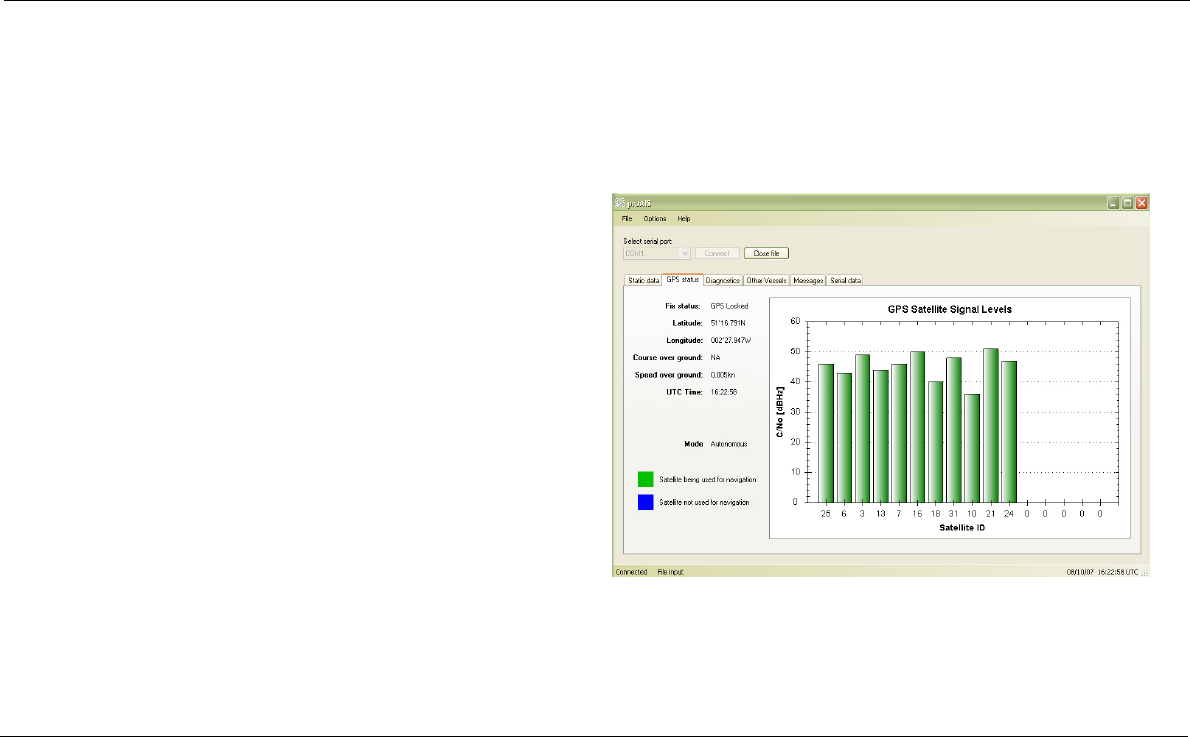
Operation
Page 20
5.3 Using proAIS with your AIS
transceiver
The proAIS tool has a range of features to help monitor the
performance of your AIS transceiver. To use the full range of
features your AIS transceiver must be installed as described in
section 3 and connected to a PC running the proAIS application.
proAIS menus
This section describes the functions available via the proAIS
menus.
The proAIS 'File' menu includes the following functions:
Open log file - this includes the ability to open a log file previously
captured using the log file capture tool.
The proAIS 'Options' menu includes the following functions:
Beep on AIS transmission - the PC will make an audible beep
when an AIS message is transmitted.
Force connection - forces proAIS to make a connection with the
AIS unit even when no response is received from the unit.
The proAIS 'Help' menu includes the following functions:
About - details of the version number of the proAIS software you
have installed.
proAIS GPS status page
The 'GPS status' page shows the signal strength of each satellite
being received and the dynamic data of the vessel. Satellite signals
shown as green bars are actively being used calculate a position fix.
If position fix cannot be achieved then no dynamic data will be
shown and all signal strength bars will be blue.
Figure 15 proAIS GPS status page
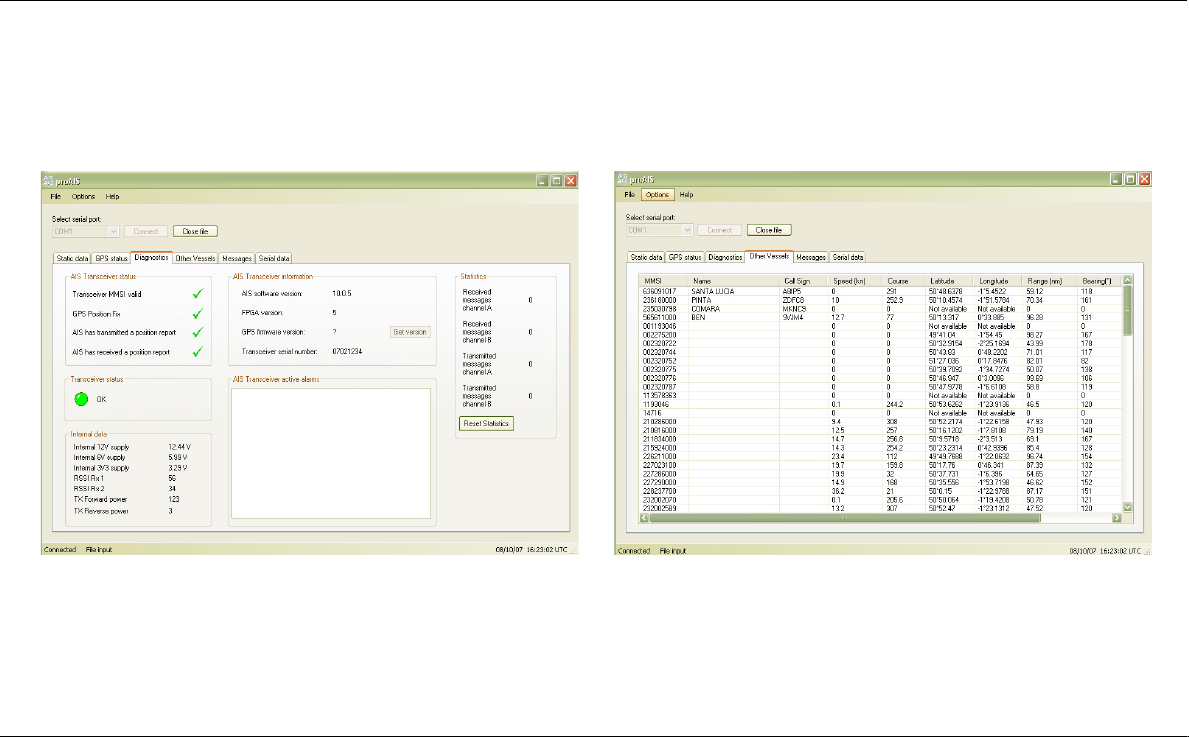
Operation
Page 21
proAIS Diagnostics page
The 'Diagnostics' page provides a range of information about the
AIS transceiver's status. Referring to the information in this page
may be useful if you are attempting to diagnose a potential issue
with the AIS transceiver's installation or operation.
Figure 16 proAIS Diagnostics page
proAIS Other vessels page
The 'Other vessels' page provides a list of all vessels from which
AIS messages are being received. For each vessel the MMSI,
name, call sign, speed and course, position, range and bearing are
shown if available.
Figure 17 proAIS Other vessels page
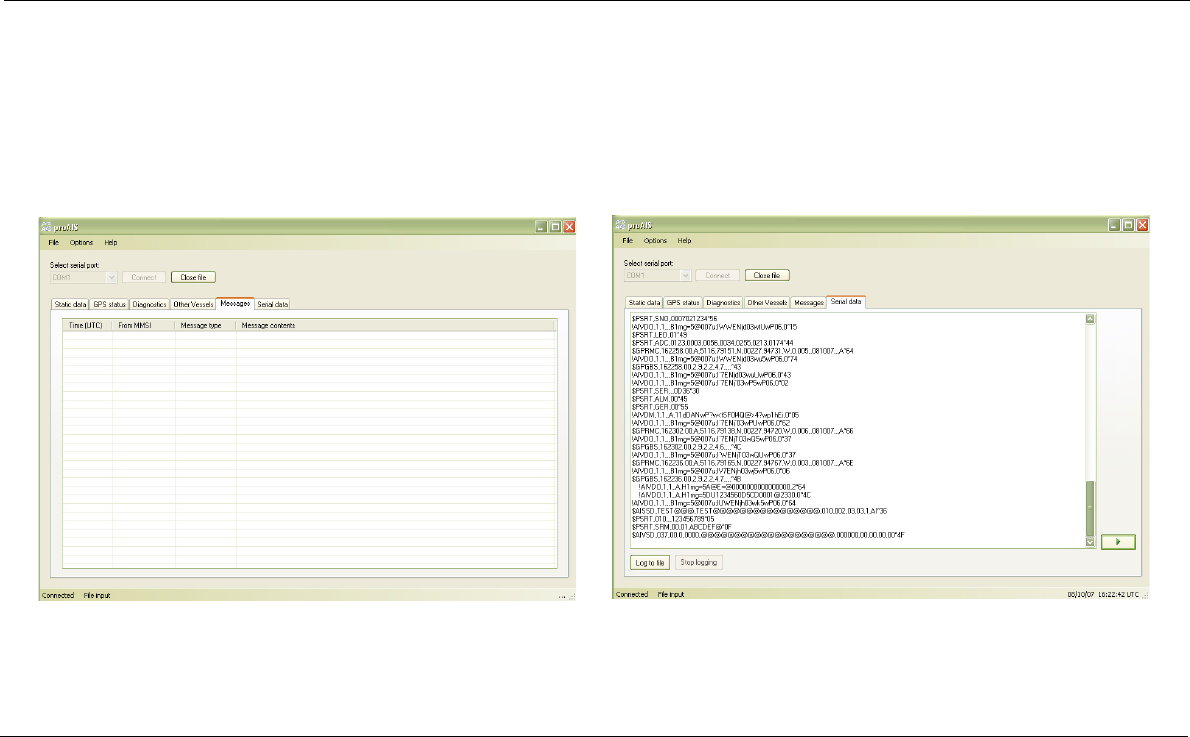
Operation
Page 22
proAIS Messages page
The 'Messages' page provides a list of all text messages received
from other vessels. These are most likely to be safety related
messages which are requests for assistance from other vessels.
Figure 18 proAIS Messages page
proAIS Serial data page
The 'Serial data' page provides a view of all incoming and outgoing
AIS messages. The messages are encoded in a special format and
it is not necessary to understand the meaning of the messages to
use the equipment. The serial data page includes the facility to
capture your AIS data during a journey and then play it back using
the 'open log file' command in the 'File' menu.
Figure 19 proAIS Serial data page
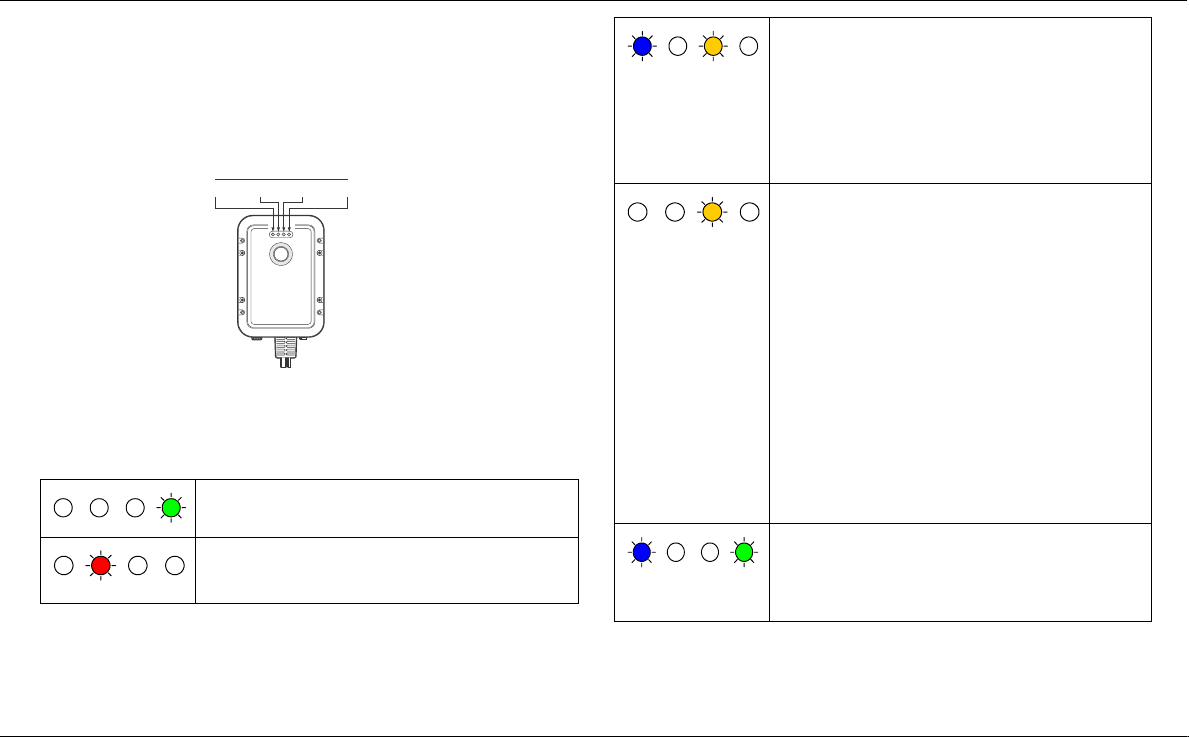
Operation
Page 23
5.4 Indicator functions
The AIS transceiver includes four coloured indicators as shown in
Figure 20. The state of the indicators provides information
regarding the status of the AIS transceiver.
Figure 20 Indicator location on the AIS transceiver unit
The meaning of typical indicator configurations is shown in the table
below and Figure 20 shows the orientation of the AIS transceiver.
The AIS transceiver is powered up, has a position fix and
has transmitted at least one vessel information report.
The AIS transceiver has detected a system error. The
likely causes of this are detailed in the troubleshooting
guide in section 6.
Indicator lights
Blue Red Amber Green
When the switch function is configured to activate the
silent mode feature and the switch has been depressed
for more than two seconds, this combination of indicators
will be illuminated to show that the transmitter is disabled.
This arrangement of indicators will also be visible if the
AIS transceiver has been configured for the blue indicator
to signify received AIS messages. In this case the blue
indicator will rapidly turn on and off as messages are
received.
The AIS transceiver is in 'transmit timeout' mode. This
can be for a number of reasons:
• The unit has only recently been powered on and is
obtaining a position fix prior to transmitting its first
vessel information report. (This process can take
several minutes).
• Position fix has been lost. The AIS transceiver will
attempt to regain position fix for 30 minutes before
entering an error state.
• The AIS radio channels are exceptionally busy so
there is currently no available timeslot for
transmission.
• The unit has been in silent mode and after deactivating
silent mode this amber indicator will illuminate until the
first AIS message has been sent
•The AIS transceiver has been commanded by the
local authority (via an AIS Basestation) to cease
transmissions.
When the switch function is configured to activate safety
related messages and the switch has been depressed for
more than two seconds the blue indicator will illuminate for
1 minute. It is not possible to send a safety related
message at a rate of more than once per minute.

Troubleshooting
Page 24
6 Troubleshooting
If the guidance given in the table above does not rectify the problem
you are experiencing, please contact your dealer for further
assistance.
Issue Possible cause and remedy
No data is being received
by the chart plotter
• Check that the power supply is connected
correctly.
• Check that the power supply is a 12V supply.
• Check that the connections to the chart plotter are
correct.
No indicators are
illuminated
• Check that the power supply is connected
correctly.
• Check that the power supply is a 12V supply.
The Red 'error' indicator
is illuminated
• The unit may not have a valid MMSI. Check that
the AIS transceiver is correctly configured with a
valid MMSI.
• The VHF antenna may be faulty. Please check
the connection to the VHF antenna and that the
VHF antenna is not damaged. The red indicator
may illuminate briefly if the power supply is
interrupted or the VHF antenna characteristics are
briefly affected.
• The GPS antenna may be faulty. Please check
the connection to the GPS antenna and that the
GPS antenna is not damaged.
• The power supply is outside the allowable range.
Check that the power supply is within the range
9.6V to 15.6V.
• If none of the above correct the error condition
please contact your dealer for advice.
My MMSI is being
received by other vessels
but my vessel name is
not shown on their chart
plotter or PC
• Some older AIS devices and chart plotters do not
process the specific class B AIS message which
provides the vessel name (message 24). This is
not a fault of your AIS transceiver. Software
upgrades are available for many older chart
plotters which will correct this issue. The other
vessel should update its AIS unit and/or chart
plotting software to receive AIS message 24.
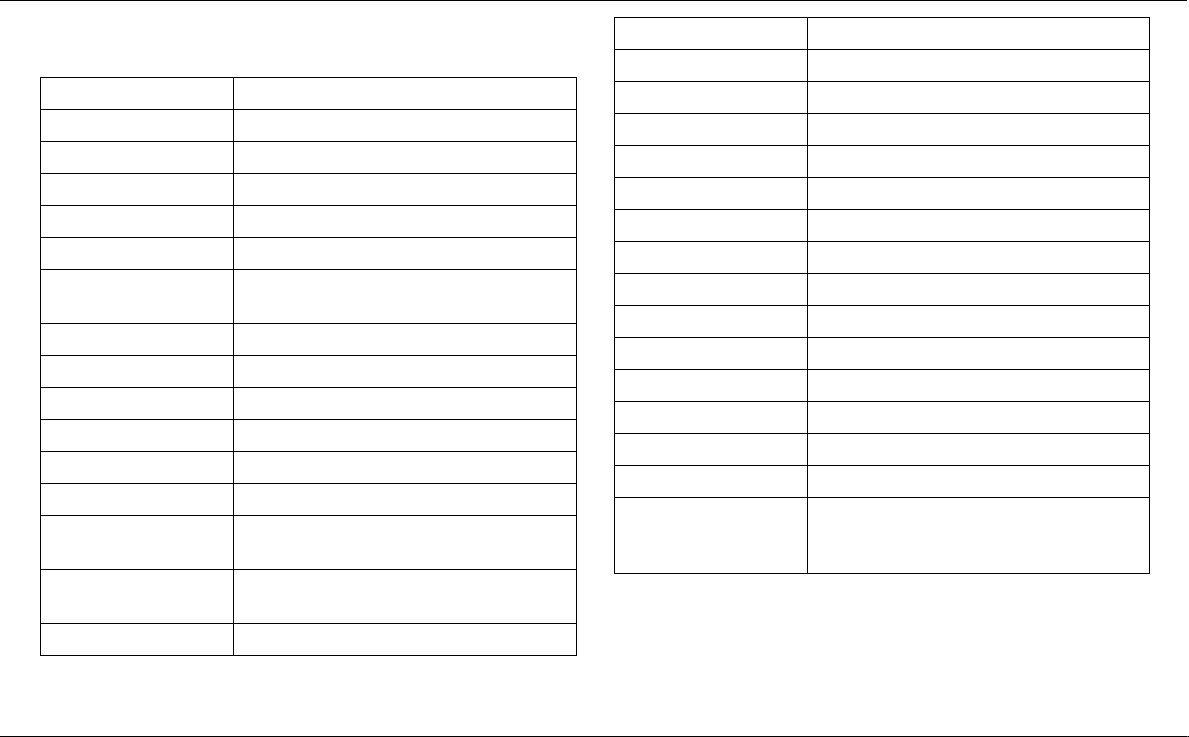
Specifications
Page 25
7 Specifications
Parameter Value
Dimensions 215 x 150 x 45 mm (L x W x H)
Weight 685g (AIS transceiver unit only)
Power DC (9.6V - 15.6V)
Average power consumption 4W
Peak current rating 2A
GPS Receiver (AIS
Internal)
16 channel IEC 61108-1 compliant
Electrical Interfaces RS232 38.4kBaud bi-directional
RS422 NMEA 38.4kBaud bi-directional
Connectors VHF antenna connector
GPS antenna connector
RS232/RS422/Power/External switch
VHF Transceiver Transmitter x 1
Receiver x 2 (One receiver time shared
between AIS and DSC)
Frequency: 156.025 to 162.025 MHz in
25 kHz steps
Output Power 33dBm ± 1.5 dB
Channel Bandwidth 25kHz
Channel Step 25kHz
Modulation Modes 25kHz GMSK (AIS, TX and RX)
25kHz AFSK (DSC, RX only)
Bit rate 9600 b/s ± 50 ppm (GMSK)
1200 b/s ± 30 ppm (FSK)
RX Sensitivity Less than -107dBm at 20% PER
Co-channel 10dB
Adjacent channel 70dB
IMD 65dB
Blocking 84dB
Environmental Water resistant to IPx7
Operating temperature: -25ºC to +55ºC
Tested to IEC 60945 'Protected' category
Indicators Power, TX timeout, error, status
Operator Controls Single switch configurable to enable
either silent mode or safety related
message functions

Warranty
Page 26
8 Warranty
What this warranty covers
The Manufacturer of this Product warrants to the Buyer that the
Product will be free from defects under normal use ("Defects") for a
period of two (2) years from the date that the Product was
purchased ("Warranty Period").
What this warranty does not cover
The Limited Warranty does not apply to normal wear and tear, does
not apply when the Product is opened or repaired by someone not
authorised by the Manufacturer and does not cover repair or
replacement of any element of the Product damaged by misuse,
moisture, exposure to heat, abuse or failure to comply with the
instructions supplied with the Product.
How to make a warranty claim
In order to make a claim of a Defect, you must contact the
Manufacturer during the Warranty Period to explain the Defect and
to obtain an RMA number (Return Materials Authorisation) if
necessary. You must return the Product during the Warranty Period
(at your own expense), along with an explanation of the Defect, to
the address provided to you by the Manufacturer. If the Warranty
claim is deemed to be valid the Manufacturer will reimburse to you
the cost of shipping and return the Product to you after repair.
Your legal rights
This Limited Warranty does not affect any legal rights under
applicable national legislation governing the sale of consumer
goods. This Limited Warranty cannot be transferred to any other
person.
Limitation of liability
The Manufacturer and its suppliers shall not be liable to you or to
any third party for any damages either direct, indirect, consequential
or otherwise including but not limited to damages for the inability to
use the equipment arising out of the use of or inability to use the
Product.
The entire liability of the Manufacturer and any of its suppliers shall
be limited to the amount actually paid by you for the Product. The
provisions of this Limited Warranty are in lieu of any other warranty,
whether expressed or implied, written or oral. The Manufacturer
and its suppliers shall not be liable for any incidental, indirect,
consequential or special (including punitive or multiple) damages,
loss of profit, business, contracts, opportunity, goodwill or other
similar loss.
Nothing in this Warranty shall limit the liability of the Manufacturer or
its suppliers in respect of death or personal injury caused by its
negligence, fraud or any other liability which by law cannot be
excluded or limited.